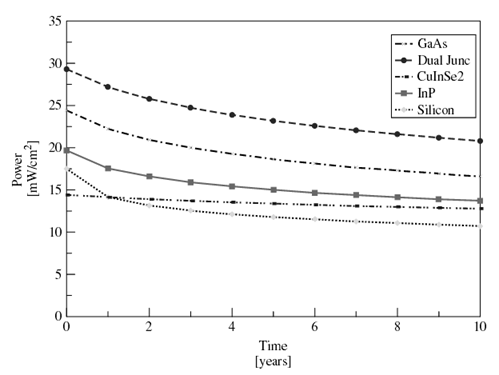

ZTG Photvolatic Cell - Advanced Triple Cell for Space Applications from Emcore features [2]:
- space qualified
- radiation resistant
- 0.92 absorptance for triple junctions [3]
- 29.5% peak solar cell efficiency
- 84 mg/cm^2
Clyde Space Lithium Polymer Battery features [4]:
- integrated battery heater
- 35000 cycle expected life
- 150 Wh/kg
- 80% depth of discharge

Multiple environmental factors also had to be considered when calculating the required capacities of the solar cell array and battery. Solar cells are susceptible to radiation damage which causes the efficiency of the cells in a space environment to decrease with time. This effect is mitigated by glass coverings and other methods, but safety in power estimation means the efficiency of the cell used in calculations should be lowered to accurately represent its end of life efficiency. From Figure 2, the efficiency at a safe margin of 4 years is 24%. This efficiency was used in our calculations.
Another factor considered was the eclipse of the Sun by Venus. Since the orbit of the satellite is relatively low and only partially inclined, the satellite will be in direct sunlight only 60% of the time. The time out of the sun was taken into account by dividing the power requirements on the solar cell by 0.6.


[2] Emcore. gZTG Photvolatic Cell - Advanced Triple Cell for Space Applicationsh. ZTJ Space Solar Cell Data Sheet. July 2014. Available: http://www.emcore.com/wp-content/uploads/ZTJ-Cell.pdf
[3] S. Bailey and R. Raffaelle. gSpace Solar Cells and Arraysh. Available: http://www.kepu.dicp.ac.cn/photo/07sl02/Handbook%20of%20Photovoltaic%20Science%20and%20Engineering/10.%20Space%20Solar%20Cells%20and%20Arrays.pdf
[4] Spacecraft Batteries Product. Available: http://www.clyde-space.com/products/spacecraft_batteries